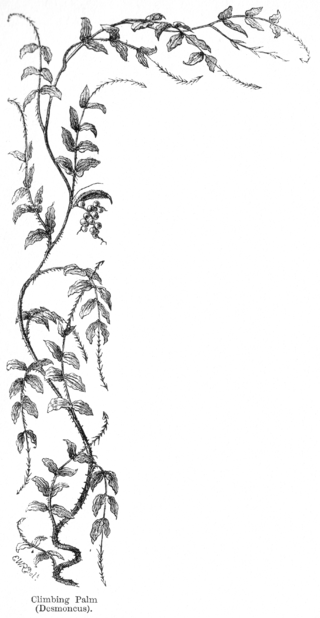
Cecropia is a Neotropical genus consisting of 61 recognized species with a highly distinctive lineage of dioecious trees. The genus consists of pioneer trees in the more or less humid parts of the Neotropics, with the majority of the species being myrmecophytic. Berg and Rosselli state that the genus is characterized by some unusual traits: spathes fully enclosing the flower-bearing parts of the inflorescences until anthesis, patches of dense indumentums (trichilia) producing Mullerian (food) at the base of the petiole, and anthers becoming detached at anthesis. Cecropia is most studied for its ecological role and association with ants. Its classification is controversial; in the past, it has been placed in the Cecropiaceae, Moraceae, or Urticaceae. The modern Angiosperm Phylogeny Group system places the "cecropiacean" group in the Urticaceae.

Carl Friedrich Philipp von Martius was a German botanist and explorer.

Trachycarpus fortunei, the Chinese windmill palm, windmill palm or Chusan palm, is a species of hardy evergreen palm tree in the family Arecaceae, native to parts of China, Japan, Myanmar and India.

Attalea maripa, commonly called maripa palm is a palm native to tropical South America and Trinidad and Tobago. It grows up 35 m (115 ft) tall and can have leaves or fronds 10–12 m (33–39 ft) long. This plant has a yellow edible fruit which is oblong ovoid and cream. An edible oil can be extracted from the pulp of the fruit and from the kernel of the seed.

Astronium graveolens is a species of flowering tree in the cashew family, Anacardiaceae, that is native to Mexico, Central America, and South America as far south as Bolivia. Common names include glassywood, ronrón (Spanish), and aroeira (Portuguese). This plant is cited in Flora Brasiliensis by Carl Friedrich Philipp von Martius.
Aegiphila sellowiana is a species of tree or shrub in the family Lamiaceae. It is native to Bolivia, Brazil, and Ecuador. Its common names include tamanqueira.

Oenocarpus bacaba is an economically important monoecious fruiting palm native to South America and the Amazon rainforest, which has edible fruits. This plant is cited in Flora Brasiliensis by Carl Friedrich Philipp von Martius. It can reach up to 20–25 metres tall and 15–25 cm in diameter. It grows in well-drained sandy soils of the Amazon basin.
Annona coriacea is a fruit tree native to Brazil. Its original habitat includes the ecoregions of Cerrado, Caatinga, and Pantanal. There, it is typically found in scrublands and savannahs, though it is sometimes grown in orchards. Its wood is used in constructions and toys. This plant is cited in Flora Brasiliensis by Carl Friedrich Philipp von Martius.

Desmoncus is a genus of mostly climbing, spiny palms native to the Neotropics. The genus extends from Mexico in the north to Brazil and Bolivia in the south, with two species present in the southeastern Caribbean.

Parajubaea torallyi, commonly known as the palma de Pasobaya or Bolivian mountain coconut, is a species of evergreen flowering plant of genus Parajubaea, in the family Arecaceae, closely related to the coconut palm in the tribe Cocoseae.

Arthrocereus glaziovii is a species of plant in the family Cactaceae. It is endemic to Brazil. Its natural habitat is rocky areas. It is threatened by habitat loss.

The Botanische Staatssammlung München is a notable herbarium and scientific center maintained by the Staatliche Naturwissenschaftliche Sammlungen Bayerns. Its building is located within the Botanischer Garten München-Nymphenburg area at Menzinger Straße 67, München, Bavaria, Germany. A center for data science and biodiversity informatics called SNSB IT Center is affiliated. Its library is open to the public; scientific collections are open to researchers by appointment.

Butia capitata, also known as jelly palm, is a Butia palm native to the states of Minas Gerais and Goiás in Brazil. It is known locally as coquinho-azedo or butiá in (northern) Minas Gerais. This palm grows up to 8m. It has feather palm pinnate leaves that arch inwards towards a thick stout trunk.

Calycophyllum spruceanum, common names capirona and Pau-Mulato, is a canopy tree belonging to the Gardenia Family (Rubiaceae) indigenous to the Amazon rainforest. Its most interesting characteristic is its very shiny, highly polished green bark. The oblong leaves are up to seven inches in length. The white flowers are in small terminal clusters.
Annona acutiflora is a species of plant in the Annonaceae family. It is native to Brazil. Carl Friedrich Philipp von Martius, the German botanist who first formally described the species, named it after the inner petals which come to a sharp point.
Annona foetida is a species of plant in the family Annonaceae. It is native to Bolivia, Brazil, Colombia, French Guiana, Peru and Suriname. Carl Friedrich Philipp von Martius, the German botanist who first formally described the species, named it after its foul-smelling odor.

Annona tenuiflora is a species of plant in the family Annonaceae. It is native to Brazil, Colombia, French Guiana and Venezuela. Carl Friedrich Philipp von Martius, the German botanist who first formally described the species, named it after the slender sepals and petals of its flowers.
Bocagea longipedunculata is a species of plant in the family Annonaceae. It is native to Brazil. Carl Friedrich Philipp von Martius, the German botanist and explorer who first formally described the species, named it after its long floral stalks.

Qualea parviflora, known as pau-terra in Portuguese, is a deciduous tree indigenous to Bolivia, Brazil, and Paraguay. The tree favors dry climates like the tropical savanna of the cerrado.
Inga cordistipula is a species of tree in the family Fabaceae. It was described by German botanist Carl Friedrich Philipp von Martius. It can be found in Colombia and Brazil.














